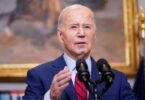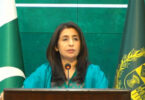NEW DELHI (Dailymail): An Indian mother has been pictured transporting her son’s corpse on a rickshaw after he died, as India’s spiralling coronavirus crisis leaves many regions without ambulances, hospital beds and oxygen.
Meanwhile, desperate relatives have turned to the black market for medical supplies for those forced to seek treatment in their homes, as India recorded 2,812 Covid deaths overnight and infections in the last 24 hours rose to 352,991 on Monday – a record peak and a new global high for a fifth day running.
The price of an oxygen cylinder would typically cost around around $80 (6,000 rupees), but price gougers are cashing in on the huge demand and in some cases charging as much as $1,300 (50,000 rupees) per cylinder.
In the most critical cases, those unable to get access to oxygen are suffocating to death, while some people have resorted to committing suicide by hurling themselves from roofs amid the hospital shortages.
To tackle the crisis, the Indian government announced on Monday that it was sending in the army to help tackle the second deadly wave currently collapsing India’s tattered healthcare system.
Meanwhile, a train dubbed ‘The Oxygen Express’ carrying 64.55 tonnes of Liquid Medical Oxygen (LMO) in oxygen tankers left for Delhi from Raigarh on Monday, the Indian Railways said according to The Times of India.
When it arrives, the supply of oxygen will offer some welcome relief in Delhi, which saw 1,777 people die between April 19 and April 24 alone – a rate of over 12 deaths an hour, or one death every five minutes.
Dr. Gautam Singh, who works in one of New Delhi’s emergency wards, resorted to posting on social media to beg for more oxygen when his hospital ran out on Sunday.
‘Please send oxygen to us,’ the 43-year-old said in an impassioned video plea posted to Twitter. ‘My patients are dying.’ He received 20 oxygen cylinders on Monday, only enough to limp the hospital through the day until the ventilators start sending out their warning beeps again.
‘I feel helpless because my patients are surviving hour to hour,’ Singh said in a telephone interview. ‘I will beg again and hope someone sends oxygen that will keep my patients alive for just another day.’
Other vital medical supplies have also seen their prices inflated, according to the BBC. Oxygen concentrators – a device that concentrates oxygen from a gas supply – once cost between $330 – $930, but have risen as high as $2,600 in some cases. The cost of drug treatments, such as Remdesivir and Tocilizumab, have also skyrocketed.
In addition to oxygen supplies running out, intensive care units are operating at full capacity and nearly all ventilators are in use. As the death toll mounts, the night skies in some Indian cities glow from the funeral pyres, as crematoria are overwhelmed and bodies are burned outside in the open air.
India was initially seen as a success story in weathering the pandemic, but the virus is now racing through its massive population of nearly 1.4 billion, and systems are beginning to collapse.
Experts believe India’s true death toll is likely much higher, saying fatalities are being under-reported in the official figure. They also say the second wave will peak in May at up to 500,000 cases a day, meaning around 5,000 people could die every day at the current case fatality ratio of 1.14 percent.
And as the country creaks under the chaos of an out-of-control coronavirus pandemic, horrific stories are beginning to emerge.
Among them, a mother was seen last week transporting her son’s dead body on a rickshaw because she couldn’t find an ambulance, as reported by Devvesh Pandey, a reporter in Bharat Samachar for BSTV Live.
News of the devastating situation in India comes as:
- Experts say that as India registered record daily-deaths, the true toll is likely even higher than official count
- Families in India have criticised authorities over treatment of their loved ones, either in hospital or deceased
- Viral video from the country has shown body being dragged down the road by health workers to be cremated
- Another showed a body calling out of an old ambulance as it was being transported to a crematorium
- Elsewhere, police brought charges against a man who left his covid-stricken mother to die on the roadside
- India’s Prime Minister Narendra Modi is facing mountain criticism as cases continue to spiral out of control
- While some have blamed the second wave on the spread of a new ‘double mutant’ variant, experts have pointed to the premature relaxation of measures, large religious gatherings and crowded election rallies
- On Saturday, Twitter complied with the government’s request and prevented people in India from viewing more than 50 tweets that appeared to criticise the administration’s handling of the pandemic
- Lawmakers and human rights activists came out against the action, saying authorities were stifling dissent
- The southern Indian state of Karnataka, home to technology and outsourcing hub Bengaluru, also announced that it will impose a lockdown for 14 days starting from the evening of April 27 to contain virus outbreak
- Neighbouring Bangladesh sealed its border with India for 14 days, its foreign ministry said on Monday
- Several cities have ordered curfews, while police have been deployed to enforce social distancing and masks
The son, who died in Varanasi of Uttar Pradesh after not getting the proper medical treatment, was initially forced to from hospital to hospital trying to find a treatment bed.
The situation got so dire, that after he died, his mother was forced to transport her son’s corpse on a rickshaw when no ambulance was available to them.
In another harrowing story in West Bengal, a man is alleged to have jumped from the roof of a hospital and died on Saturday after testing positive for Covid-19 on April 22. Upon checking CCTV footage, hospital staff are reported to have seen him break a window in his treatment room to get out onto the roof.
Elsewhere in Patna, Bihar – a city in the north-east of the country along the Ganges River – a railway employee was reported to have beheaded his wife after she tested positive for coronavirus. The accused then reportedly jumped off the terrace of his apartment to his death after committing the murder.
In a third case in Kerala in the south of the country, a bus driver was reported to have thrashed a migrant worker for not wearing a mask. A video of the incident has been circulated on social media, showing an elderly man being hit and later lying on the floor covered in blood.
A video shared widely online showed the body of a coronavirus victim falling from an old ambulance drafted in to help with the crisis on Friday when it was being carried to a crematorium in Vidisha district of Madhya Pradesh.
According to The Times of India, the family saw the video and said they were shocked to see the body of their loved one falling out of the side door of the ambulance as it turned a corner sharply after leaving the Atal Bihari Vajpayee Government Medical College.
It is not known how many bodies had been loaded into the old ambulance when the incident took place.
As the body was left on the road, the ambulance pulled over, and families of other coronavirus patients waiting outside the medical centre immediately started protesting about the treatment of their loved ones.
In some cases, families have spoken of not being told when their relatives have died, and others alleged that hospital administrators are not allowing them to see patients.
‘My relative has died, but the hospital is not providing any details. We don’t even known whether he died this evening or yesterday itself. No one is telling us anything. We have been waiting for 4-5 hours outside the hospital,’ Prakash Lodhi said to India Today.
Officials have said they cannot possibly allow everyone to visit their loved ones in the overcrowded hospitals, and have said the reason for the delay in notifying loved ones of the death of their family member’s is down to procedure being followed when handing a body over.
Elsewhere, television channel NDTV broadcast images of three health workers in the eastern state of Bihar pulling a body along the ground on its way to cremation, as stretchers ran short.
The three healthcare workers are shown struggling with the body wrapped up in a bed sheet, as they pulled it out the back of a van and then along a dirt road towards where it would be cremated.
At least 52 people on ONE flight from Delhi to Hong Kong test positive for Covid-19
At least 52 people from a single flight have tested positive for Covid-19, despite all passengers presenting a negative coronavirus test before boarding.
All of the passengers who tested positive flew into Hong Kong on a flight from Delhi, run by Indian airline Vistara on April 4.
Hong Kong as a whole has been recording fewer daily new infections that the total number detected on the flight, since it brought a fourth wave of infections under control in January.
A total of 188 passengers could have been on-board the flight, but Hong Kong authorities did not disclose how many people were on-board the plane.
The positive results have surfaced during the mandatory three-week quarantine period enforced by Hong Kong. It is one of the strictest entry measures in the world.
All passengers flying into the territory must present a negative test within 72 hours before departing.
Several cases have also been detected on flights arriving into Hong Kong from Mumbai, according to authorities.
The territory has since banned all flights from India, Pakistan and Philippines from April 20 to May 3.
In another incident, police have brought charges against a man who allegedly abandoned his mother by the roadside in Kanpur, Uttar Pradesh after she tested positive for Covid-19.
Authorities were alerted to the incident when a video went viral on social media, showing the woman lying by the roadside. Local residents took her to a local hospital, where she died while being treated.
On Sunday, Prime Minister Narendra Modi urged all citizens to get vaccinated and said India had been hit by a Covid ‘storm’, weeks after boasting that the country had defeated Covid, while hospitals and doctors have put out urgent notices saying they are unable to cope with the rush of patients.
Nearly all intensive care unit (ICU) beds used to treat Covid patients in three of India’s most populated regions – Delhi, Mumbai and Ahmedabad – are full, meaning they are being forced to run away patients, leaving families to ferry people sick with coronavirus from hospital to hospital in search for treatment and patients dying on pavements outside.
‘Currently the hospital is in beg-and-borrow mode and it is an extreme crisis situation,’ said a spokesman for the Sir Ganga Ram Hospital in the capital, New Delhi.
India, with a population of over 1.3 billion, has a tally of 17.31 million infections and 195,123 deaths, after 2,812 deaths overnight, health ministry data showed, although health experts say the death count is probably far higher.
In Delhi alone, 1,777 people died between April 19 and April 24 – a rate of over 12 deaths an hour, or one death every five minutes.
The week prior (April 12 to 17) saw 677 deaths – about five deaths per hour – but experts have said the rising figures are not expected to stop, predicting that the second wave will peak in May at up to 500,000 cases a day, meaning around 5,000 people could die every day at the current case fatality ratio of 1.14 percent.
As bad as the situation is, experts warn it is likely to get worse.
Krishna Udayakumar, founding director of the Duke Global Health Innovation Center at Duke University, said it would be impossible for the country to keep up with needs over the coming days as things stand.
‘The situation in India is tragic and likely to get worse for some weeks to months,’ he said, adding that a ‘concerted, global effort to help India at this time of crisis’ is desperately needed.
The scale of the second wave knocked oil prices on Monday, as traders worried about a fall in fuel demand in the world’s third-biggest oil importer.
Also on Sunday, Britain’s Prime Minister Boris Johnson pledged to support India in its battle against the devastating Covid surge, and a shipment of 495 oxygen concentrators as well as ventilators were sent from Britain to help the crisis.
Meanwhile, President Joe Biden said the United States would send raw materials for vaccines, medical equipment and protective gear to India, although did not suggest sending surplus vaccine doses.
The White House said the U.S. is ‘working around the clock’ to deploy testing kits, ventilators and personal protective equipment, and it would seek to provide oxygen supplies as well. It said it would also make available sources of raw material urgently needed to manufacture Covishield, the Oxford-AstraZeneca vaccine made by the Serum Institute of India.
‘Just as India sent assistance to the United States as our hospitals were strained early in the pandemic, we are determined to help India in its time of need,’ President Joe Biden said in a tweet.
Help and support were also offered from archrival Pakistan, which said it could provide relief including ventilators, oxygen supply kits, digital X-ray machines, protective equipment and related items.
Germany’s Health Ministry said it was ‘urgently working to put together an aid package’ for India consisting of ventilators, monoclonal antibodies, the drug Remdesivir, as well as surgical and N95 protective masks.
The EU has pledged to meet on May 8 to discuss sending aid to India.
India’s second wave has been devastating, and has been put down to a number of factors.
Many have blamed a new ‘double mutant’ variant, thought to be more infectious than the first, but others have pointed to the premature reopening of public places, large religious gatherings and crowded election rallies.
On June 18 last year, India recorded 11,000 cases. In the 60 days that followed, an average of 35,000 cases were seen per-day.
On February 10 this year, at the start of the second wave, India confirmed 11,000 cases again. In the next 50 days, the daily average of new infections stayed at around 20,000 cases per-day.
But in the following 10 days after that, cases rose sharply – reaching 89,800 per-day – an exponential increase.
Experts say that the rapid increase shows that the second wave is spreading around the country mast faster than the first wave did.
Speaking to the broadcaster, Dr A Fathahudeen – who is part of Kerala state’s Covid taskforce – said there were already signs in February, but that the country ‘did not get out act together’.
‘I said in February that Covid had not gone anywhere and a tsunami would hit us if urgent actions were not taken. Sadly, a tsunami has indeed hit us now,’ he added.
‘A false sense of normalcy crept in and everybody, including people and officials, did not take measures to stop the second wave.’
Politicians, especially Modi, have faced criticism for holding rallies attended by thousands of people, packed close together in stadiums and grounds, despite the brutal second wave of infections.
Several cities in India have ordered curfews, while police have been deployed to enforce social distancing and mask-wearing.
Still, about 8.6 million voters were expected to cast ballots on Monday in the eastern state of West Bengal, in the penultimate part of an eight-phase election that will wrap up this week.
Voting for local elections in other parts of India included the most populous state of Uttar Pradesh, which has been reporting an average of 30,000 infections a day.
Stung by criticism of its lack of preparation ahead of the wave of infections, the federal government has asked industrialists to increase the production of oxygen and life-saving drugs in short supply.
But many say it is too late – the breakdown a stark failure for a country that boasted of being a model for other developing nations.
Only three months ago, the country’s leaders were boisterous, delivering messages that the worse was over.
In January, Prime Minister Narendra Modi declared victory over the coronavirus, telling the virtual gathering of the World Economic Forum that India’s success couldn’t be compared with anywhere else.
A little less than a month later, his Bharatiya Janata Party passed a resolution hailing Modi as a ‘visionary leader’ who had already ‘defeated’ the virus.
By the second week of March, India’s health minister declared that the country was ‘in the endgame’ of the pandemic.
At the same time, the patients arriving at India’s hospitals were far sicker and younger than previously seen, prompting warnings by health experts that India was sitting on a ticking timebomb, which went either unnoticed or ignored.
Millions of Hindu devotees celebrated the festival of Holi across the country at the end of March, foregoing social distancing guidelines and masks. Politicians, including Modi, spearheaded mammoth election rallies where tens of thousands participated without masks. And millions more gathered by the Ganges River for special Hindu prayers as recently as last week.
Now it’s suspected all these events might have accelerated the unprecedented surge India is seeing now.
‘Many people across India are paying with their lives for that shameful behavior by political leaders,’ Udayakumar said.
In a radio address on Sunday, Modi sought to deflect the criticism and said the ‘storm’ of infections had left the country ‘shaken.’
‘It is true that many people are getting infected with corona,’ he said. ‘But the number of people recovering from corona is equally high.’
India’s government said last week it would expand its vaccination program to make all adults eligible, something long urged by health experts.
But vaccinations take time to show their effect on the numbers of new infections, and there are questions of whether manufacturers will be able to keep up with the demand. The pace of vaccination across the country also appears to be struggling.
Modi’s plea on vaccinations came after inoculations peaked at 4.5 million doses on April 5, but have since averaged about 2.7 million a day, government figures show.
Several states, including Maharashtra, the richest, halted vaccinations in some places on Sunday, saying supplies were not available.
Supply has fallen short of demand as the inoculation campaign was widened this month, while companies struggle to boost output, partly because of a shortage of raw material and a fire at a facility making the AstraZeneca dose.
Hospitals in Modi’s home state of Gujarat are among those facing an acute shortage of oxygen, doctors said.
Just seven ICU beds of a total of 1,277 were available in 166 private hospitals designated to treat the virus in the western state’s largest city of Ahmedabad, data showed.
‘The problem is grim everywhere, especially in smaller hospitals, which do not have central oxygen lines and use cylinders,’ said Mona Desai, former president of the Ahmedabad Medical Association.
The crisis unfolding in India is most visceral in its graveyards and crematoriums, and in heartbreaking images of gasping patients dying on their way to hospitals due to lack of oxygen.
Burial grounds in the Indian capital New Delhi are running out of space and bright, glowing funeral pyres light up the night sky in other badly hit cities.
‘If you’ve never been to a cremation, the smell of death never leaves you,’ Vipin Narang, a political science professor at Massachusetts Institute of Technology (MIT) in the United States, said on Twitter.
‘My heart breaks for all my friends and family in Delhi and India going through this hell.’
In central Bhopal city, some crematoriums have increased their capacity from dozens of pyres to more than 50. Yet, officials say, there are still hours-long waits.
At the city’s Bhadbhada Vishram Ghat crematorium, workers said they cremated more than 110 people on Saturday, even as government figures in the entire city of 1.8 million put the total number of deaths at just 10.
‘The virus is swallowing our city’s people like a monster,’ said Mamtesh Sharma, an official at the site.
The unprecedented rush of bodies has forced the crematorium to skip individual ceremonies and exhaustive rituals that Hindus believe release the soul from the cycle of rebirth.
‘We are just burning bodies as they arrive,’ said Sharma. ‘It is as if we are in the middle of a war.’
The head gravedigger at New Delhi’s largest Muslim cemetery, where 1,000 people have been buried during the pandemic, said more bodies are arriving now than last year. ‘I fear we will run out of space very soon,’ said Mohammad Shameem.
The situation is equally grim at unbearably full hospitals, where desperate people are dying in line, sometimes on the roads outside, waiting to see doctors.
Health officials are scrambling to expand critical care units and stock up on dwindling supplies of oxygen. Hospitals and patients alike are struggling to procure scarce medical equipment that is being sold at an exponential markup.
The crisis is in direct contrast with government claims that ‘nobody in the country was left without oxygen,’ in a statement made Saturday by India’s Solicitor General Tushar Mehta before Delhi High Court.
The breakdown is a stark failure for a country whose prime minister only in January had declared victory over COVID-19, and which boasted of being the ‘world’s pharmacy,’ a global producer of vaccines and a model for other developing nations.
Caught off-guard by the latest deadly spike, the federal government has asked industrialists to increase the production of oxygen and other life-saving drugs in short supply.
But health experts say India had an entire year to prepare for the inevitable – and it didn’t.
Dr. Krutika Kuppalli, assistant professor of medicine in the division of infectious diseases at the Medical University of South Carolina, said the Indian government has been ‘very reactive to this situation rather than being proactive.’
She said the government should have used the last year, when the virus was more under control, to develop plans to address a surge and ‘stockpiled medications and developed public-private partnerships to help with manufacturing essential resources in the event of a situation like this.’
‘Most importantly, they should have looked at what was going on in other parts of the world and understood that it was a matter of time before they would be in a similar situation,’ Kuppalli said.
Kuppalli called the government’s premature declarations of victory over the pandemic a ‘false narrative,’ which encouraged people to relax health measures when they should have continued strict adherence to physical distancing, wearing masks and avoiding large crowds.
Neighbouring Bangladesh sealed its border with India for 14 days, its foreign ministry said on Monday, though trade will continue. Air travel has been suspended since Bangladesh imposed a lockdown on April 14 to combat record infections and deaths.
‘The borders should not reopen until the situation in India improves,’ virologist and government adviser Nazrul Islam told Reuters.
‘If the highly contagious Indian variant enters the country, the situation can’t be controlled in any way.’
The southern Indian state of Karnataka, home to technology and outsourcing hub Bengaluru, also announced that it will impose a lockdown for 14 days starting from the evening of April 27 in an effort to contain the surge infection, the state’s chief minister said on Monday.
Karnataka is the latest region to enter a lockdown after similar curbs in many parts of India, which is battling a massive second wave of infections that has pressured its health system.
Bengaluru, a city of 12 million, reported more than 20,000 new infections on Sunday, its highest single-day tally so far and second only to the capital, Delhi.
Prime Minister Narendra Modi is facing mounting criticism for allowing Hindu festivals and attending mammoth election rallies that experts suspect accelerated the spread of infections.
His Hindu nationalist government is trying to quell critical voices.
On Saturday, Twitter complied with the government’s request and prevented people in India from viewing more than 50 tweets that appeared to criticise the administration’s handling of the pandemic.
The targeted posts include tweets from opposition ministers critical of Modi, journalists and ordinary Indians.
Lawmakers and human rights activists said on Monday that the removal of the tweets was putting people’s health at risk and quashing dissent.
Dr. Anant Bhan, a bioethics and global health expert, has been critical of the government’s handling of the crisis, and has said that the significance of the new variant has been over-played.
‘It’s not the virus variants and mutations which are a key cause of the current rise in infections,’ he said. ‘It’s the variants of ineptitude and abdication of public health thinking by our decision makers.’
The surge has also been fuelled by a ‘double mutant’ variant, thought to be more infectious, but Dr Jameel believes ‘too much’ has been made of the mutation.
Instead, he claims the spiralling infection rates were impacted by the lack of messaging for people to take vaccinations in January and February when case numbers were down.
He added: ‘In all the euphoria, in all the patting of our backs that we have done so well, we are out of it, we weren’t. We were just as susceptible as anybody else.
‘So if there is a lesson here to be learned, it’s that you have to be on your guard. You have to prepare. We should have been stocking up on oxygen.
‘We should have been messaging clearly for people to take vaccines in the months of January and February when the cases were down. If that happened at scale at that time, then we wouldn’t be facing this situation today.
‘So many things have gone wrong but instead of crying over spilled milk I think it’s important to learn some lessons, get some good data, and plan for the future because this is not the end of it.’
Last week, the Supreme Court told the Indian government to produce a national plan for the supply of oxygen and essential drugs for the treatment of coronavirus patients.
Ministers said today they would exempt vaccines, oxygen and other oxygen-related equipment from customs duty for three months, in a bid to boost availability.
In addition, Modi’s emergency assistance fund, dubbed PM CARES, in January allocated some £19million ($27million) to set up 162 oxygen generation plants inside public health facilities in the country.
But three months on, only 33 have been created, according to the federal Health Ministry.
Despite this, the Defense Ministry is set to fly 23 mobile oxygen generating plants into India from Germany within a week to be deployed at army-run hospitals catering to Covid-19 patients.
Each plant will be able to produce 2,400 litres of oxygen per hour, a government statement said yesterday.
The latest comes as Boris Johnson pledged to support India in its battle against the devastating Covid surge which has brought the country to its knees.
The UK is ‘looking at what we can do to help’ after India reported a record-breaking number of new cases in a single day for four days in a row.
Mr Johnson said: ‘We’re looking at what we can do to help and support the people of India, possibly with ventilators.
‘Thanks to the ventilator challenge, the huge efforts of British manufacturers, we’re better able now to deliver ventilators to other countries.
‘But also possibly with therapeutics, dexamethasone, other things, we’ll look at what we can do to help.’
Meanwhile, U.S. President Joe Biden said the United States was ‘determined to help India in its time of need,’ immediately making available supplies of vaccine-production material, therapeutics, tests, ventilators and protective equipment.
So far 132 cases of the Indian variant have been detected in Britain, around half of which are in London.
The variant contains two mutations in the virus’s spike protein, which could help it spread more easily and evade vaccines.
India was added to the UK’s travel ‘red list’ yesterday, prompting a last-minute scramble for flights to Heathrow.
The British Prime Minister had also cancelled a trip to New Delhi over the weekend where he had hoped to secure millions of vaccine doses.
Government scientists said border measures are not enough to prevent the spread of new variants, but they can delay it.
One senior source said there were likely to be ‘many more’ cases of the Indian variant in the UK than the 132 detected so far.
They added: ‘It does look like it’s more transmissible but we don’t know if it is more transmissible than the Kent variant and we don’t have any data on vaccine efficacy.’
Across the northern border, authorities in Nepal were grappling to contain the rapid rise of COVID-19 cases with experts fearing that thousands of people in the Himalayan state have caught the more infectious mutant strains emerging out of India.
Nepal, which shares a long porous border with India, reported 3,032 new infections on Sunday, the highest daily surge recorded this year. It took the total caseload since the pandemic first struck Nepal to 300,119, and there have so far been 3,164 deaths, according to government data.
‘We have detected the UK variant and the double mutant variant detected in India,’ Krishna Prasad Paudel, the director of Nepal’s Epidemiology and Disease Control Department Paudel told Reuters, adding that experts were checking for other variants too.
Nepal launched its vaccination campaign in January and gave shots to 1.9 million people, all provided by India and China. But health experts feared that continuation of the vaccination drive was uncertain after officials had failed to procure more vaccine shots from India or any other source.
Over 90 developing nations, including Nepal, rely on India, home to the Serum Institute, the world’s largest vaccine maker, for the doses to protect their own populations, but India has now prioritised its own needs as a second wave of the epidemic there has run out of control.
‘The virus is mutating very fast…what started in India has now entered Nepal too,’ said Rabindra Pandey, a public health expert, adding that if the trend continued for a week then new patients will be unable to find any beds as hospitals were already stretched.
Wedged between China and India, Nepal shares a 1,751-kilometre (1,094 miles) border with its southern neighbour India. The border was closed for some time during a lockdown last year, when the first wave of the epidemic struck, but it has since been reopened.
Nepal’s former king Gyanendra and his wife, who tested positive for the virus after returning from India where they attended a religious festival, were undergoing treatment at a private facility in Kathmandu.
‘The situation is really frightening,’ said Prakash Thapa, a doctor at Bheri hospital in Nepalgunj, a city in the southwest plains bordering India.
He said the hospital was inundated with coronavirus patients requiring intensive care and ventilators.
‘This time even children and young people are brought in critical condition and patients are even sleeping on the floor and corridors,’ he said.
Nepal’s ruling Communist party has been embroiled in a power struggle for months, and Prime Minister K.P. Sharma Oli has been criticised for his response to the crisis.
Foreign Minister Pradeep Gyawali told reporters on Sunday that despite the surge in cases a national level lockdown was not required.
Nepal’s economy contracted for the first time in four decades in the last fiscal year due to a months-long lockdown to contain the COVID-19 pandemic.






